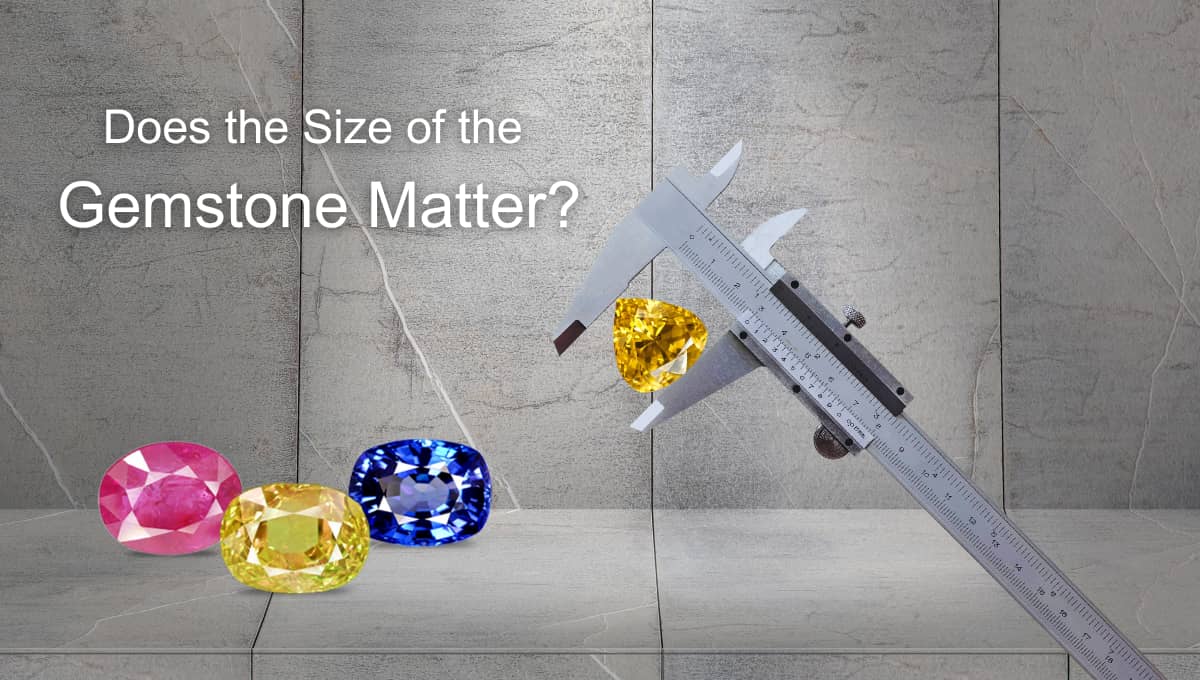When it comes to quantifying a gemstone’s quality, the 4C’s (color, cut, carat weight, and clarity play a crucial role. Out of all 4C’s factors, carat weight or gemstone weight is unquestionably the most predominant factor. There is no denying that a larger gem can undoubtedly make a striking impression but there’s much more to consider than sheer size when it comes to gemstone selection. The allure of a gemstone lies in a delicate balance of factors: color, clarity, cut, and carat weight. Each of these elements contributes to the gem’s overall beauty and value. Imagine the vibrant sparkle of a perfectly cut diamond, the deep, rich hue of a finely polished sapphire, or the flawless clarity of an emerald that draws the eye into its depths.
These characteristics can make even smaller stones exceptionally desirable. Moreover, the significance of a gemstone often extends beyond its physical attributes, encompassing personal, cultural, and symbolic meanings that can transcend its dimensions. In this enticing blog post, we’ll delve into the significance of carat weight and how the true value of a gemstone is determined by a symphony of qualities that harmonize to create its unique charm and significance.
Table of Contents
Gemstone Size & How It is Measured
Gemstone size refers to the physical dimensions of a gemstone, typically measured in millimeters (mm) for length, width, and depth, and sometimes in carats for weight. The size of a yellow sapphire gemstone can affect its visual impact and value, but it’s not the sole determinant of its quality or desirability. Moreover, the size of a gemstone also plays a significant role in Astrology. In the domain of Gemology, Gemstone size is described by two main factors: carat weight and millimeter dimensions.
Carat weight is a unit of mass used specifically for gemstones and pearls. One carat is equal to 200 milligrams (0.2 grams). This applies to all gemstones, not just diamonds. It’s important to remember that carat weight doesn’t necessarily reflect the visual size of a gemstone, because different gemstones have different densities.
Millimeter dimensions refer to the length, width, and depth of a gemstone in millimeters (mm). This is the most accurate way to measure a gemstone’s size visually. Knowing the millimeter dimensions is important when setting a gemstone in jewelry, as the stone needs to fit the setting properly.
Read Worthy: – Single Source Gemstones
Significance of Gemstone Size
When choosing an original hessonite gemstone, one question often arises numerous times: does size matter? The answer, like most things in the world of gemstones, is nuanced and specific. Size indeed plays a role in several aspects, but it’s not the sole factor to consider in determining overall quality of a gemstone. Let’s delve deeper into the importance of gemstone size:
Visual Impact and Value:
Larger stones naturally grab attention. A statement ring with a sizable blue sapphire gemstone is undeniably eye-catching. However, size isn’t everything. Color, clarity, and cut all contribute to a gemstone’s value and visual impact. A smaller, high-quality stone can hold more brilliance than a larger, flawed one.
Setting and Style:
Size needs to complement the setting. A delicate pendant wouldn’t accommodate a massive gemstone, while a chunky cocktail ring might look unbalanced with a tiny stone. Consider the overall design and ensure the stone size creates a harmonious piece.
Don’t Miss: – How To Identify Fake Gemstones
Comfort and Wearability:
Oversized gemstones can be impractical and uncomfortable to wear. A giant yellow sapphire ring on your finger might snag on everything, or a heavy necklace could strain your neck. Comfort is the ultimate key, especially for gemstone jewelry you plan to wear daily.
Astrological Beliefs:
Certain schools of thought in astrology emphasize the importance of gemstone size for optimal energy transfer. Recommendations may vary, but generally, a stone large enough for proper skin contact is preferred.
Budget Considerations:
Larger stones are generally way more expensive than small to mid-size gemstones. Rarity also plays a role. A large, high-quality stone of a rare variety can command a hefty price tag which can make a serious dent in your pocket. Finding the right balance between size and quality is crucial for budget-conscious buyers.
When Size Might Be More Important:
Certain cutting styles may benefit from larger stones. For example, opals with a play-of-color effect need a larger surface area to fully showcase their beauty.
Also Read: – Gemstones for Meditation
Does the Size of the Gemstone Really Matter?
There’s no one-size-fits-all answer when it comes to gemstone size. It’s a balancing act between various factors – visual appeal, setting compatibility, comfort, budget, and even personal preference. Here are some key takeaways for our valued readers they must look on before making a hasty decision solely :
Prioritize quality. A smaller, high-quality stone can be more effective and valuable than a larger, flawed one.
Consider the purpose. Is your selected red coral stone a statement piece or everyday wear? Choose a size that complements the intended use.
Don’t be afraid of smaller stones. They can be just as beautiful and impactful.
Seek expert advice. A reputable jeweler can guide you on size based on the specific gemstone, setting, and your personal needs.
Ultimately, the perfect gemstone size is the one that speaks to you. Whether it’s a dazzling statement piece or a subtle everyday gem, choose a size that complements your style and brings you joy.
Check Out: – Can I Wear Gemstones During Shradh
